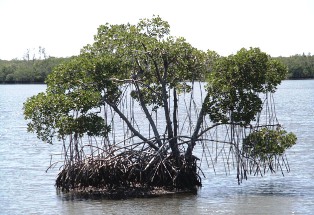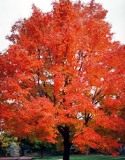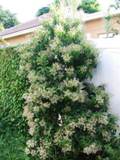Discover Florida Nature
It's time to explore the natural Florida


|
|
|
|
|
 (Southern)
Magnolia
(Magnolia grandiflora)- Southern magnolia is a large, broad-leafed
evergreen tree that can grow 60-90 ft in height with a trunk up to 2-3
ft in diameter. It's trunk is typically straight and erect with
spreading branches that form a dense, broadly pyramidal crown. The
evergreen leaves are large 5-8 in long, leathery and dark glossy green
above with rusty, velveteen undersides. Southern magnolia has large,
showy white flowers that are 8-12 in in diameter. These have a pleasant
fragrance and appear throughout the spring and summer. The fruits are
reddish-brown cone-like structures, 2-4 in long, with bright red kidney
shaped seeds that hang from little threads when fully mature in autumn. (Southern)
Magnolia
(Magnolia grandiflora)- Southern magnolia is a large, broad-leafed
evergreen tree that can grow 60-90 ft in height with a trunk up to 2-3
ft in diameter. It's trunk is typically straight and erect with
spreading branches that form a dense, broadly pyramidal crown. The
evergreen leaves are large 5-8 in long, leathery and dark glossy green
above with rusty, velveteen undersides. Southern magnolia has large,
showy white flowers that are 8-12 in in diameter. These have a pleasant
fragrance and appear throughout the spring and summer. The fruits are
reddish-brown cone-like structures, 2-4 in long, with bright red kidney
shaped seeds that hang from little threads when fully mature in autumn. Mangrove:
Mangroves are one of Florida’s true natives. You are most likely to
see mangroves in any coastal community from Tampa Bay south. Mangroves
are very important to the ecosystem because they are the base of the
food chain, provide valuable habitat, prevent erosion, filter out
pollution, and are important nursery areas for shellfish, crustaceans
and juvenile fish. Mangrove:
Mangroves are one of Florida’s true natives. You are most likely to
see mangroves in any coastal community from Tampa Bay south. Mangroves
are very important to the ecosystem because they are the base of the
food chain, provide valuable habitat, prevent erosion, filter out
pollution, and are important nursery areas for shellfish, crustaceans
and juvenile fish.Red Mangrove (Rhizophora mangle) - The red mangrove is a tall tree that reaches 70' to 80' in height in the tropics; however in Florida, it is characterized as a short bushy tree reaching about 20' in height. It is characterized by its numerous above ground roots called prop roots. The flowers on the red mangrove are a pale yellow and appear in the spring. White Mangrove (Laguncularia racemosa)- You can identify a white mangrove by its leaves. They are light yellow green, oval-shaped and have a notched tip. Additionally, the leaves have two distinguishing glands at the base of the leaf blade where the stem starts. The two glands pump out the salt and sugar that the plant produces. You may see ants or other insects enjoying the sugar. The white mangrove usually grows in the highest elevations farther upland than either the red or black mangroves. The white mangrove has no visible aerial root systems like the black or red mangroves. Black Mangrove (Avicennia germinans)- At high tides, the water will cover the roots of the Black mangrove. This is the largest of the mangroves and can grow up to 50 feet tall. It has numerous breathing tubes, called pneumatophores, which grow vertically up from the mud and provide air to the roots. The leaves are slender and pointed with a silvery gray backing.  Buttonwood
(Conocarpus erectus)- Considered the fourth mangrove by some,
this native tree grows to heights of 30 feet or more and was used
extensively in the days of old to manufacture charcoal. It is still used
for smoking fish and other meats. There are two species of the
buttonwood along the tidal walk – the more prominent Green buttonwood
and the Silver buttonwood. These slow-growing trees can withstand salt,
wind and drought, which make them invaluable coastal plants. The small
cones resembling buttons give the tree its name. Buttonwood trees make
excellent landscape trees for your Florida-friendly yard. Buttonwood
(Conocarpus erectus)- Considered the fourth mangrove by some,
this native tree grows to heights of 30 feet or more and was used
extensively in the days of old to manufacture charcoal. It is still used
for smoking fish and other meats. There are two species of the
buttonwood along the tidal walk – the more prominent Green buttonwood
and the Silver buttonwood. These slow-growing trees can withstand salt,
wind and drought, which make them invaluable coastal plants. The small
cones resembling buttons give the tree its name. Buttonwood trees make
excellent landscape trees for your Florida-friendly yard. (Red)
Maple (Acer rubrum L)- The red maple tree is a deciduous tree
that will often grow to between forty and sixty feet tall. The crown of
a red maple tree is rounded to oval in shape. In northern sates, red
maple trees usually occur in low wetlands or river flood plains. In the
southern states, they usually occur naturally in drier, upland areas.
The leaves of a red maple tree are shiny green on top and pale green
beneath. They typically have three to five lobes, and are three to six
inches across. The flowers are small and red, appearing in dense
clusters from late March to early April. The flowers are followed by
small red fruit appearing in early summer. Red maple trees also have
reddish stems and twigs. Red maple trees are fast growing maple trees,
which prefer full sun, but will also grow in full shade. They are widely
adaptable in the soils in which they grow. Hardy in zones four through
ten, they make excellent additions to any landscape. Red maple trees are
highly ornamental, especially during the flowering period and in the
fall months. (Red)
Maple (Acer rubrum L)- The red maple tree is a deciduous tree
that will often grow to between forty and sixty feet tall. The crown of
a red maple tree is rounded to oval in shape. In northern sates, red
maple trees usually occur in low wetlands or river flood plains. In the
southern states, they usually occur naturally in drier, upland areas.
The leaves of a red maple tree are shiny green on top and pale green
beneath. They typically have three to five lobes, and are three to six
inches across. The flowers are small and red, appearing in dense
clusters from late March to early April. The flowers are followed by
small red fruit appearing in early summer. Red maple trees also have
reddish stems and twigs. Red maple trees are fast growing maple trees,
which prefer full sun, but will also grow in full shade. They are widely
adaptable in the soils in which they grow. Hardy in zones four through
ten, they make excellent additions to any landscape. Red maple trees are
highly ornamental, especially during the flowering period and in the
fall months. Marlberry
(Ardisia escallonioides) - Marlberry is also known as marbleberry and
dogberry. Marlberry is somewhat common in the coastal hammocks and
pinelands of south Florida and the Keys. It occasionally is found as far
north as Flager County in Florida. Usually an understory species,
marlberry grows in the shade of taller trees such as pines and cabbage
palm throughout its range that includes, besides Florida, the West
Indies, Mexico, and Guatemala. Native Americans in Florida called this
tree, the black tobacco-seasoning tree, because they mixed its leaves
with their tobacco to make it go further. The tart, acidic fruit is
edible but unappealing to people. It is useful to birds, squirrels, and
other mammals gathering food. Its rich, dark, hard, heavy wood is not
economically important due to the small size of the tree. Marlberry
(Ardisia escallonioides) - Marlberry is also known as marbleberry and
dogberry. Marlberry is somewhat common in the coastal hammocks and
pinelands of south Florida and the Keys. It occasionally is found as far
north as Flager County in Florida. Usually an understory species,
marlberry grows in the shade of taller trees such as pines and cabbage
palm throughout its range that includes, besides Florida, the West
Indies, Mexico, and Guatemala. Native Americans in Florida called this
tree, the black tobacco-seasoning tree, because they mixed its leaves
with their tobacco to make it go further. The tart, acidic fruit is
edible but unappealing to people. It is useful to birds, squirrels, and
other mammals gathering food. Its rich, dark, hard, heavy wood is not
economically important due to the small size of the tree. Myrsine
(Rapanea punctata) -Myrsine, also known as Guiana rapanea and rapanea,
is found in a variety of habitats usually near coastal areas. You can
find myrsine in Florida, and in the West Indies, Mexico, and South
America. In Florida, myrsine is more common in south Florida and the
Keys. Native Americans in Florida called this tree, the white
tobacco-seasoning tree, because they mixed its leaves with their tobacco
to make it go further. The fruit is edible but unappealing to people. It
is useful to songbirds as a food source. The bark has been used in
leather tanning but otherwise myrsine has no commercial value. Myrsine
is a member of the Myrsinaceae family. This family has over 1,000
species of tropical trees and shrubs but only two members, myrsine and
marlberry, are present in the United States, both only in Florida. Myrsine
(Rapanea punctata) -Myrsine, also known as Guiana rapanea and rapanea,
is found in a variety of habitats usually near coastal areas. You can
find myrsine in Florida, and in the West Indies, Mexico, and South
America. In Florida, myrsine is more common in south Florida and the
Keys. Native Americans in Florida called this tree, the white
tobacco-seasoning tree, because they mixed its leaves with their tobacco
to make it go further. The fruit is edible but unappealing to people. It
is useful to songbirds as a food source. The bark has been used in
leather tanning but otherwise myrsine has no commercial value. Myrsine
is a member of the Myrsinaceae family. This family has over 1,000
species of tropical trees and shrubs but only two members, myrsine and
marlberry, are present in the United States, both only in Florida.
|
|
|
Advertise | Privacy Statement | Dog Encyclopedia | Video |Contact | Alaska Nature |
|